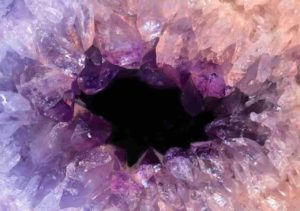
Amethyst is a purple quartz type (SiO2) and owes its violet color to irradiation, iron impurities and, in some cases, other transition metals, and the presence of other trace elements resulting in complex crystal lattice substitutions. The hardness of the stone is the same as quartz, making it ideal for use in jewelry.
Amethyst occurs in primary shades from a light pinkish purple color to a deep purple color. Amethyst may have one or both secondary shades, red and blue. High-quality amethyst can be found in Russia, Sri Lanka, Peru, Uruguay and the Far East. The perfect classification is called “Ultra Siberian” which has a predominant purple hue of around 75–80 per cent, with 15–20 per cent blue which (depending on the light source) red secondary hues. ‘Rose de France’ has a distinctly light shade of purple, reminiscent of a lavender / lila shade. These pale colors were once considered undesirable but have recently become popular as a result of intensive marketing.
How does Amethyst get its color?
The color of amethyst has been shown to result from the substitution of trivalent iron (Fe3 +) for silicon in the structure in the presence of trace elements of a large ion radius and, to a certain extent, the amethyst color can naturally result from the displacement of the transition elements even if the iron concentration is low. Real amethyst is dichroic in reddish violet and blue violet, but when it is hot, it turns yellow-orange, yellow-brown, or dark brownish, and can resemble citrine, but, unlike true citrine, it lacks its dichroic. Amethyst can result in ametrine when partially heated.
The color of the amethyst comes from the quartz color centers. They are produced when small amounts of iron are irradiated (from the normal radiation in the rocks).
The purple color of ghost town glass comes from small amounts of manganese in the glass when exposed to ultraviolet light. Manganese was used as a clearing ingredient in glass from 1860 to 1915. Compared to this, lead was used, followed by the use of selenium.
Quartz will commonly contain trace amounts of iron (from 10 to 100 parts per million pieces of iron). Some of this iron is present in sites normally occupied by silicon, and some are interstitial (in sites where the atom is not normally present). The iron is usually at +3 valence.
Gamma ray radiation (from radioactive decay in the underlying rocks) is capable of shaking the electron out of the iron lattice and depositing the electron in the interstitial carbon. This +4 iron absorbs those wavelengths (357 and 545 nanometres) of light producing the colour of the amethyst. You need to get a quartz that contains the right amount of iron and then undergoes sufficiently natural radiation to create the color centers.
Amethyst Identification
Color: Purple, violet, dark purple
Crystal habit: 6-sided prism ending in 6-sided pyramid (typical)
Twinning: Dauphine law, Brazil law, and Japan law
Cleavage: None
Fracture: Conchoidal
Mohs scale hardness: 7–lower in impure varieties
Luster: Vitreous/glassy
Streak: White
Diaphaneity: Transparent to translucent
Specific gravity: 2.65 constant; variable in impure varieties










